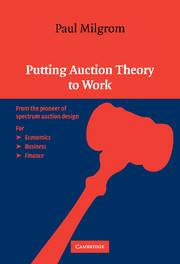Foreword by Evan Kwerel
Published online by Cambridge University Press: 05 June 2012
Summary
Paul Milgrom has had an enormous influence on the most important recent application of auction theory for the same reason you will want to read this book – clarity of thought and expression. In August 1993, President Clinton signed legislation granting the Federal Communications Commission the authority to auction spectrum licenses and requiring it to begin the first auction within a year. With no prior auction experience and a tight deadline, the normal bureaucratic behavior would have been to adopt a “tried and true” auction design. In 1993 however, there was no tried and true method appropriate for the circumstances – multiple licenses with potentially highly interdependent values. I had been advocating the use of auctions to select FCC licensees since 1983, when I joined the staff of the FCC's Office of Plans and Policy. When auction legislation finally passed, I was given the task of developing an auction design.
One of the first auction design issues the FCC considered was whether to use an ascending bid mechanism or a single round sealed bid. The federal government generally used sealed-bid auctions, especially for high valued rights such as offshore oil and gas leases. FCC staff felt reasonably confident that we could implement a sealed-bid auction – keep the bids secure, open the bids, and select the high bids. There were doubts whether we could do anything more complex. In the end, the FCC chose an ascending bid mechanism largely because we believed that providing bidders with more information would likely increase efficiency and, as shown by Milgrom and Weber (1982a), mitigate the winner's curse.
- Type
- Chapter
- Information
- Putting Auction Theory to Work , pp. xv - xxiiPublisher: Cambridge University PressPrint publication year: 2004
- 1
- Cited by



